Identification of a Quality Marker of Vinegar-Processed Curcuma Zedoaria on Oxidative Liver Injury
Abstract
1. Introduction
2. Results
2.1. Discriminatory Component Identification
2.2. Comparison of Hepatoprotective Activities by L02 Assays
2.3. Comparison of Hepatoprotective Activities by HBMEC Assays
2.4. Quality Marker Identification
3. Discussion
4. Materials and Methods
4.1. Cell Culture Materials and Chemicals
4.2. Sample Collection and Preparation
4.3. Gas Chromatography and Mass Spectrometry Settings
4.4. Data Processing and Discriminatory Component Analysis
4.5. Cell models of Oxidant Stress
4.6. Cell Viability Assays
4.7. ALT, AST, Total AOC, GSH, MDA, SOD, and GR Assay
4.8. Reactive Oxygen Species (ROS) Assay
4.9. Tube Formation Assay
4.10. DAPI Staining
4.11. Apoptosis Analysis by Flow Cytometric Using Annexin V-FITC/Propidium Iodide (PI) Staining
4.12. Statistical Analysis
Supplementary Materials
Author Contributions
Funding
Conflicts of Interest
Abbreviations
| TCM | traditional Chinese medicine |
| L02 | normal hepatic cell line |
| HBMEC | human brain microvascular endothelial cell |
| t-BHP | tertbutyl hydfroperoxide |
| total AOC | total antioxidant capacity |
References
- Tatsuta, M.; Iishi, H.; Baba, M.; Narahara, H.; Yano, H.; Sakai, N. Suppression by Chai-hu-gui-zhi-tang of the development of liver lesions induced by N-nitrosomorpholine in Sprague–Dawley rats. N.a. Lett. 2000, 152, 31–36. [Google Scholar] [CrossRef]
- Du, C.Y.Q.; Choi, R.C.Y.; Zheng, K.Y.Z.; Dong, T.T.X.; Lau, D.T.W.; Tsim, K.W.K. Yu Ping Feng San, an Ancient Chinese Herbal Decoction Containing Astragali Radix, Atractylodis Macrocephalae Rhizoma and Saposhnikoviae Radix, Regulates the Release of Cytokines in Murine Macrophages. PLOS ONE 2013, 8, e78622. [Google Scholar] [CrossRef] [PubMed]
- Wang, D.; Zhang, L.; Huang, X.; Wang, X.; Yang, R.; Mao, J.; Wang, X.; Wang, X.; Zhang, Q.; Li, P. Identification of Nutritional Components in Black Sesame Determined by Widely Targeted Metabolomics and Traditional Chinese Medicines. Molecules 2018, 23, 23. [Google Scholar] [CrossRef]
- Yang, W.; Zhang, Y.; Wu, W.; Huang, L.; Guo, D.; Liu, C. Approaches to establish Q-markers for the quality standards of traditional Chinese medicines. N.a. Pharm. Sin. B 2017, 7, 439–446. [Google Scholar] [CrossRef] [PubMed]
- Chen, T.-B.; Zuo, Y.-H.; Dong, G.-T.; Liu, L.; Zhou, H. An integrated strategy for rapid discovery and identification of quality markers in Guanxin Kangtai preparation using UHPLC-TOF/MS and multivariate statistical analysis. Phytomedicine 2018, 44, 239–246. [Google Scholar] [CrossRef]
- Wang, L.; Zhou, G.-B.; Liu, P.; Song, J.-H.; Liang, Y.; Yan, X.-J.; Xu, F.; Wang, B.-S.; Mao, J.-H.; Shen, Z.-X.; et al. Dissection of mechanisms of Chinese medicinal formula Realgar-Indigo naturalis as an effective treatment for promyelocytic leukemia. Proc. Acad. Sci. 2008, 105, 4826–4831. [Google Scholar] [CrossRef] [PubMed]
- Suhre, K.; Shin, S.-Y.; Petersen, A.-K.; Mohney, R.P.; Meredith, D.; Wägele, B.; Altmaier, E.; Deloukas, P.; Erdmann, J.; Grundberg, E.; et al. Human metabolic individuality in biomedical and pharmaceutical research. Nature 2011, 477, 54–60. [Google Scholar] [CrossRef]
- Sun, H.; Zhang, A.-H.; Zou, D.-X.; Sun, W.-J.; Wu, X.-H.; Wang, X.-J. Metabolomics Coupled with Pattern Recognition and Pathway Analysis on Potential Biomarkers in Liver Injury and Hepatoprotective Effects of Yinchenhao. Appl. Biochem. Biotechnol. 2014, 173, 857–869. [Google Scholar] [CrossRef] [PubMed]
- Jung, E.B.; Trinh, T.A.; Lee, T.K.; Yamabe, N.; Kang, K.S.; Song, J.H.; Choi, S.; Lee, S.; Jang, T.S.; Kim, K.H.; et al. Curcuzedoalide contributes to the cytotoxicity of Curcuma zedoaria rhizomes against human gastric cancer AGS cells through induction of apoptosis. J. Ethnopharmacol. 2018, 213, 48–55. [Google Scholar] [CrossRef]
- Hadisaputri, Y.E.; Miyazaki, T.; Suzuki, S.; Kubo, N.; Zuhrotun, A.; Yokobori, T.; Abdulah, R.; Yazawa, S.; Kuwano, H. Molecular characterization of antitumor effects of the rhizome extract from Curcuma zedoaria on human esophageal carcinoma cells. Int. J. Oncol. 2015, 47, 2255–2263. [Google Scholar]
- Mou, S.; Zhou, Z.; He, Y.; Liu, F.; Gong, L. Curcumin inhibits cell proliferation and promotes apoptosis of laryngeal cancer cells through Bcl-2 and PI3K/Akt, and by upregulating miR-15a. Oncol. Lett. 2017, 14, 4937–4942. [Google Scholar] [CrossRef]
- Tariq, S.; Imran, M.; Mushtaq, Z.; Asghar, N. Phytopreventive antihypercholesterolmic and antilipidemic perspectives of zedoary (Curcuma Zedoaria Roscoe.) herbal tea. Lipids Heal. 2016, 15, 393. [Google Scholar] [CrossRef]
- Akter, J.; Hossain, M.A.; Takara, K.; Islam, M.Z.; Hou, D.X. Antioxidant activity of different species and varieties of turmeric (Curcuma spp): Isolation of active compounds. Comp. Biochem. Physiol. C Toxicol. Pharmacol. 2019, 215, 9–17. [Google Scholar] [CrossRef] [PubMed]
- Xu, N.; Wang, L.; Guan, J.; Tang, C.; He, N.; Zhang, W.; Fu, S. Wound healing effects of a Curcuma zedoaria polysaccharide with platelet-rich plasma exosomes assembled on chitosan/silk hydrogel sponge in a diabetic rat model. Int. J. Boil. Macromol. 2018, 117, 102–107. [Google Scholar] [CrossRef] [PubMed]
- Ayati, Z.; Ramezani, M.; Amiri, M.S.; Moghadam, A.T.; Rahimi, H.; Abdollahzade, A.; Emami, S.A.; Sahebkar, A. Ethnobotany, phytochemistry and traditional uses of Curcuma spp. and pharmacological profile of two important species (C. longa and C. zedoaria): a review. Curr. Pharm. Des. 2019, 25, 1. [Google Scholar]
- Lee, T.K.; Trinh, T.A.; Lee, S.R.; Kim, S.; So, H.M.; Moon, E.; Hwang, G.S.; Kang, K.S.; Kim, J.H.; Yamabe, N.; et al. Bioactivity-based analysis and chemical characterization of anti-inflammatory compounds from Curcuma zedoaria rhizomes using LPS-stimulated RAW264.7 cells. Bioorganic Chem. 2019, 82, 26–32. [Google Scholar] [CrossRef]
- Hamdi, O.A.A.; Awang, K.; Hadi, A.H.A.; Syamsir, D.R.; Ng, S.W.; Hamdi, O.A.A.; Hadi, A.H.A. Curcumenol from Curcuma zedoaria: a second monoclinic modification. N.a. Crystallogr. Sect. E Struct. Rep. N.a. 2010, 66, o2844. [Google Scholar] [CrossRef]
- Wang, J.-B.; Cui, H.-R.; Wang, R.-L.; Zhang, C.-E.; Niu, M.; Bai, Z.-F.; Xu, G.-H.; Li, P.-Y.; Jiang, W.-Y.; Han, J.-J.; et al. A systems pharmacology-oriented discovery of a new therapeutic use of the TCM formula Liuweiwuling for liver failure. Sci. Rep. 2018, 8, 5645. [Google Scholar] [CrossRef] [PubMed]
- Cui, Y.-T.; Liu, B.; Xie, J.; Xu, P.; Habte-Tsion, H.-M.; Zhang, Y.-Y. The effect of emodin on cytotoxicity, apoptosis and antioxidant capacity in the hepatic cells of grass carp (Ctenopharyngodon idellus). Fish Immunol. 2014, 38, 74–79. [Google Scholar] [CrossRef]
- LeCouter, J.; Moritz, D.R.; Li, B.; Phillips, G.L.; Liang, X.H.; Gerber, H.-P.; Hillan, K.J.; Ferrara, N. Angiogenesis-Independent Endothelial Protection of Liver: Role of VEGFR-1. Science 2003, 299, 890–893. [Google Scholar] [CrossRef]
- Phan, S.H.; Gannon, D.E.; Varani, J.; Ryan, U.S.; Ward, P.A. Xanthine oxidase activity in rat pulmonary artery endothelial cells and its alteration by activated neutrophils. Am. J. Pathol. 1989, 134, 1201–1211. [Google Scholar] [PubMed]
- An, J.; Harms, C.; Lättig-Tünnemann, G.; Sellge, G.; Mandić, A.D.; Malato, Y.; Heuser, A.; Endres, M.; Trautwein, C.; Donath, S. TAT-apoptosis repressor with caspase recruitment domain protein transduction rescues mice from fulminant liver failure. Hepatology 2012, 56, 715–726. [Google Scholar] [CrossRef]
- Bernal, W.; Wendon, J. Acute liver failure. N. Engl. J. Med. 2013, 369, 2525–2534. [Google Scholar] [CrossRef]
- Lan, T.T.P.; Huy, N.D.; Luong, N.N.; Van Nghi, N.; Tan, T.H.; Quan, L.V.; Loc, N.H. Identification and Characterization of Genes in the Curcuminoid Pathway of Curcuma zedoaria Roscoe. Pharm. Biotechnol. 2018, 19, 839–846. [Google Scholar] [CrossRef]
- Bao, W.; Li, K.; Rong, S.; Yao, P.; Hao, L.; Ying, C.; Zhang, X.; Nussler, A.; Liu, L. Curcumin alleviates ethanol-induced hepatocytes oxidative damage involving heme oxygenase-1 induction. J. Ethnopharmacol. 2010, 128, 549–553. [Google Scholar] [CrossRef] [PubMed]
- Yao, Q.; Lin, Y.; Li, X.; Shen, X.; Wang, J.; Tu, C. Curcumin ameliorates intrahepatic angiogenesis and capillarization of the sinusoids in carbon tetrachloride-induced rat liver fibrosis. Toxicol. Lett. 2013, 222, 72–82. [Google Scholar] [CrossRef] [PubMed]
- Chen, W.; Lu, Y.; Wu, J.; Gao, M.; Wang, A.; Xu, B. Beta-elemene inhibits melanoma growth and metastasis via suppressing vascular endothelial growth factor-mediated angiogenesis. Cancer Chemother. Pharmacol. 2011, 67, 799–808. [Google Scholar] [CrossRef] [PubMed]
- Rajagopalan, R.; Sridharana, S.; Menon, V.P. Hepatoprotective role of bis-demethoxy curcumin analog on the expression of matrix metalloproteinase induced by alcohol and polyunsaturated fatty acid in rats. Toxicol. Mech. Methods 2010, 20, 252–259. [Google Scholar] [CrossRef] [PubMed]
- Cheng, J.-J.; Yang, N.-B.; Wu, L.; Lin, J.-L.; Dai, G.-X.; Zhu, J.-Y. Effects of zedoary turmeric oil on P450 activities in rats with liver cirrhosis induced by thioacetamide. Int. J. Clin. Exp. Pathol. 2014, 7, 7854–7862. [Google Scholar]
- Li, R.; Xiang, C.; Ye, M.; Li, H.-F.; Zhang, X.; Guo, D.-A. Qualitative and quantitative analysis of curcuminoids in herbal medicines derived from Curcuma species. N.a. Chem. 2011, 126, 1890–1895. [Google Scholar] [CrossRef]
- Xiang, Z.; Wang, X.-Q.; Cai, X.-J.; Zeng, S. Metabolomics Study on Quality Control and Discrimination of Three Curcuma Species based on Gas Chromatograph-Mass Spectrometry. Phytochem. Anal. 2011, 22, 411–418. [Google Scholar] [CrossRef]
- Shuhendler, A.J.; Pu, K.; Cui, L.; Uetrecht, J.P.; Rao, J. Real-time imaging of oxidative and nitrosative stress in the liver of live animals for drug-toxicity testing. Nat. Biotechnol. 2014, 32, 373–380. [Google Scholar] [CrossRef]
- Lei, X.G.; Zhu, J.H.; Cheng, W.H.; Bao, Y.; Ho, Y.S.; Reddi, A.R.; Holmgren, A.; Arner, E.S. Paradoxical Roles of Antioxidant Enzymes: Basic Mechanisms and Health Implications. Physiol. Rev. 2016, 96, 307–364. [Google Scholar] [CrossRef]
- Araújo, A.M.; Bastos, M.D.L.; Fernandes, E.; Carvalho, F.; Carvalho, M.; De Pinho, P.G. GC–MS metabolomics reveals disturbed metabolic pathways in primary mouse hepatocytes exposed to subtoxic levels of 3,4-methylenedioxymethamphetamine (MDMA). Arch. Toxicol. 2018, 92, 3307–3323. [Google Scholar] [CrossRef]
Sample Availability: Samples of the compounds (beta-Myrcene, Epicurzerenone, and so on) are not available from the authors. |
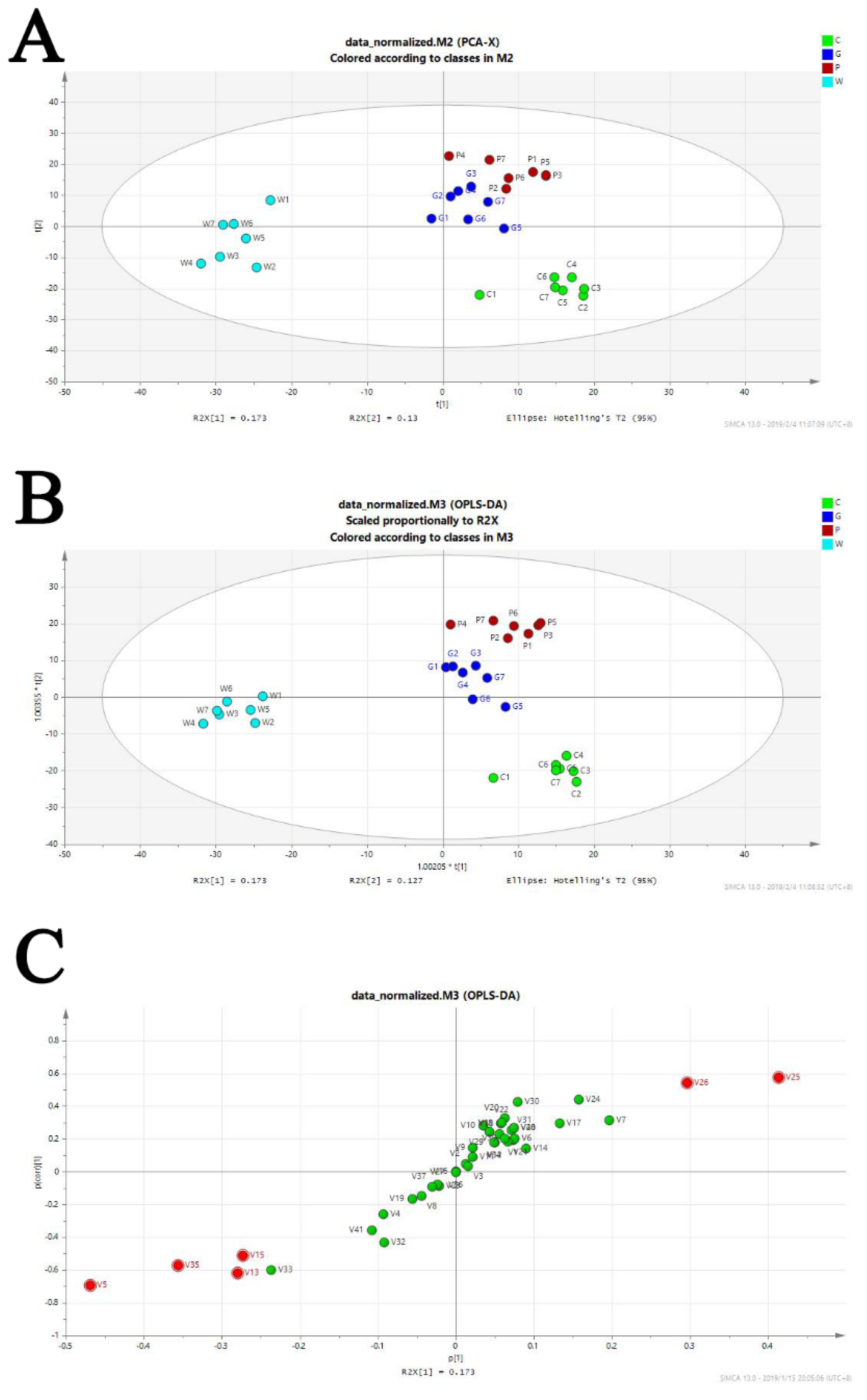

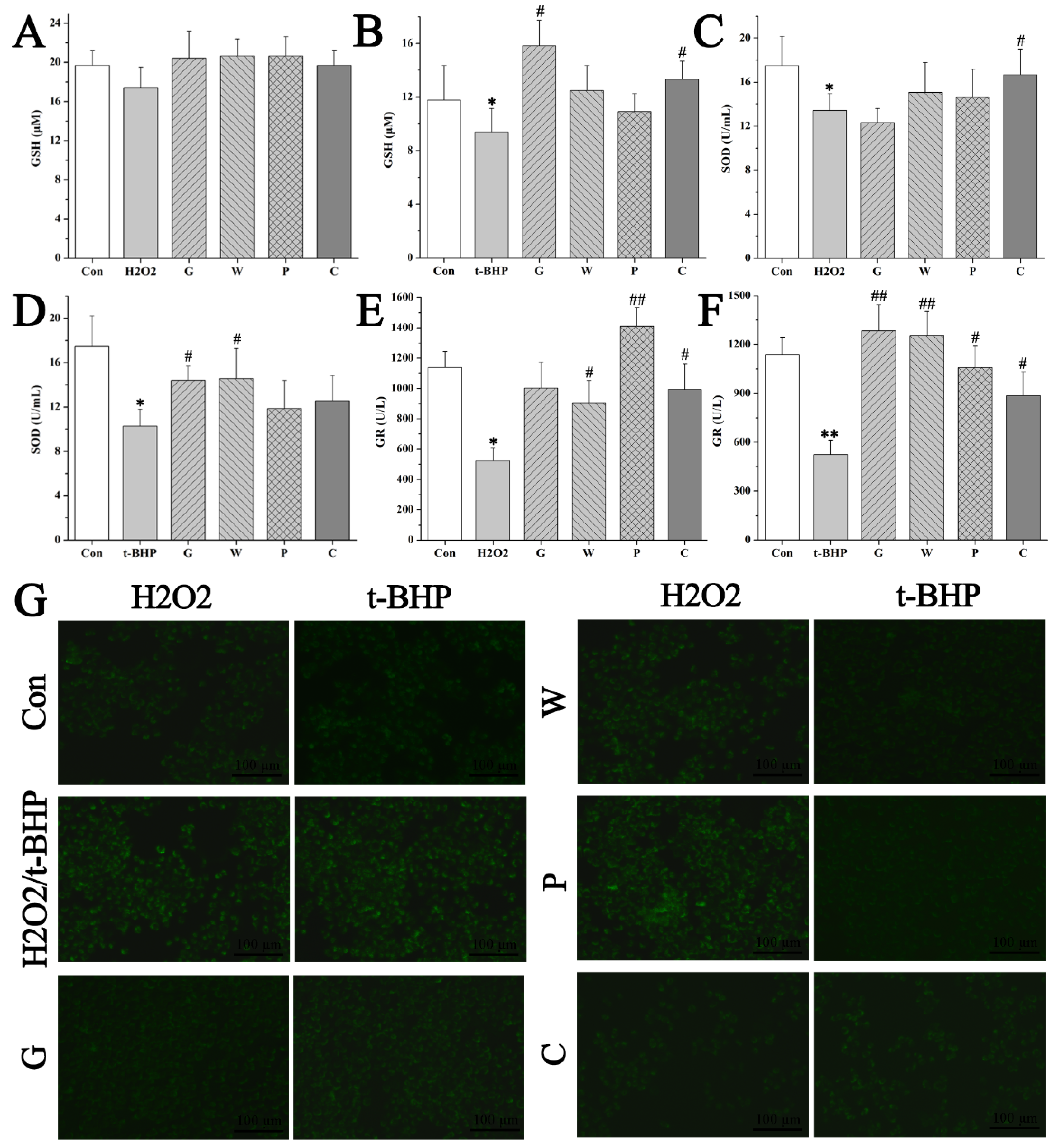
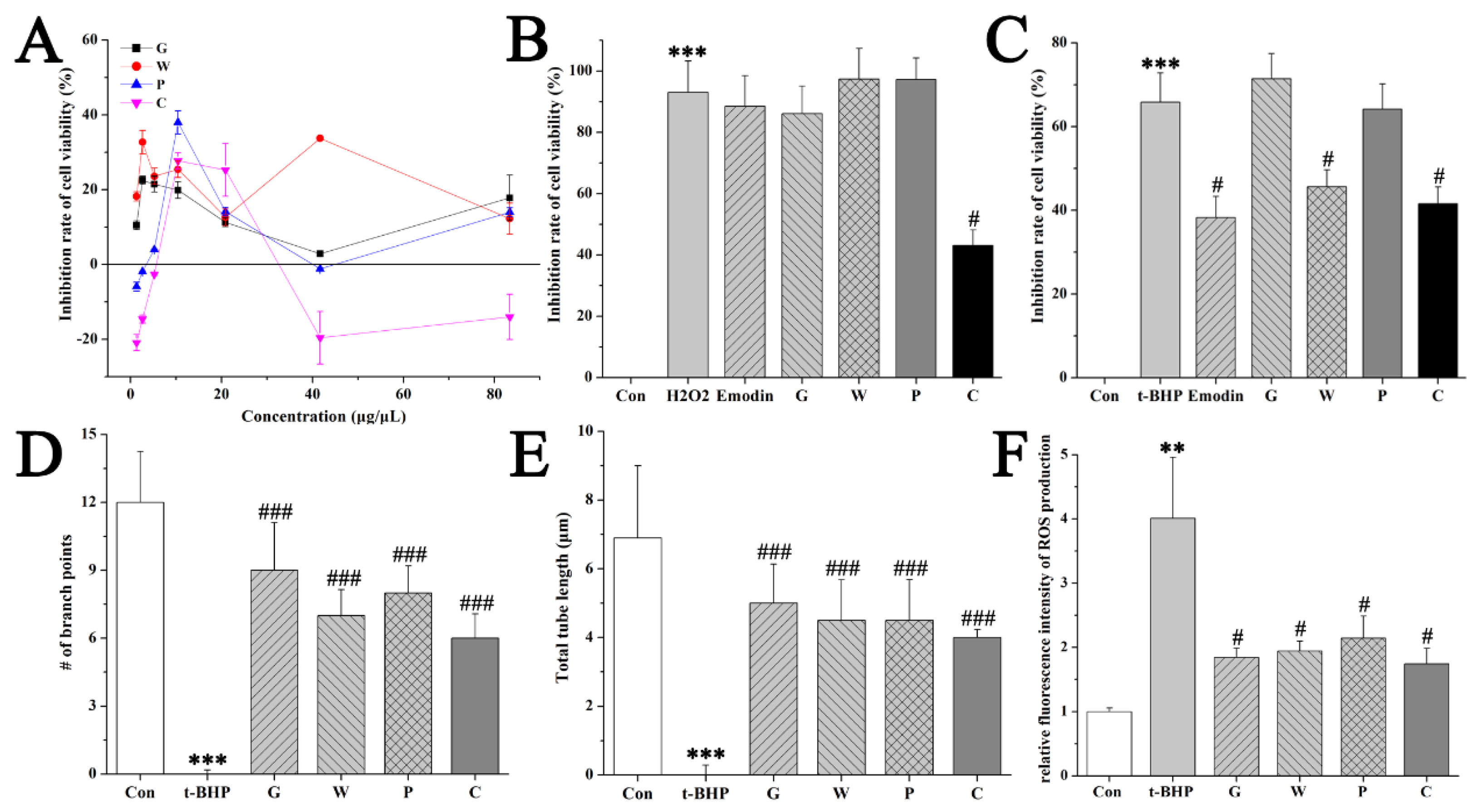
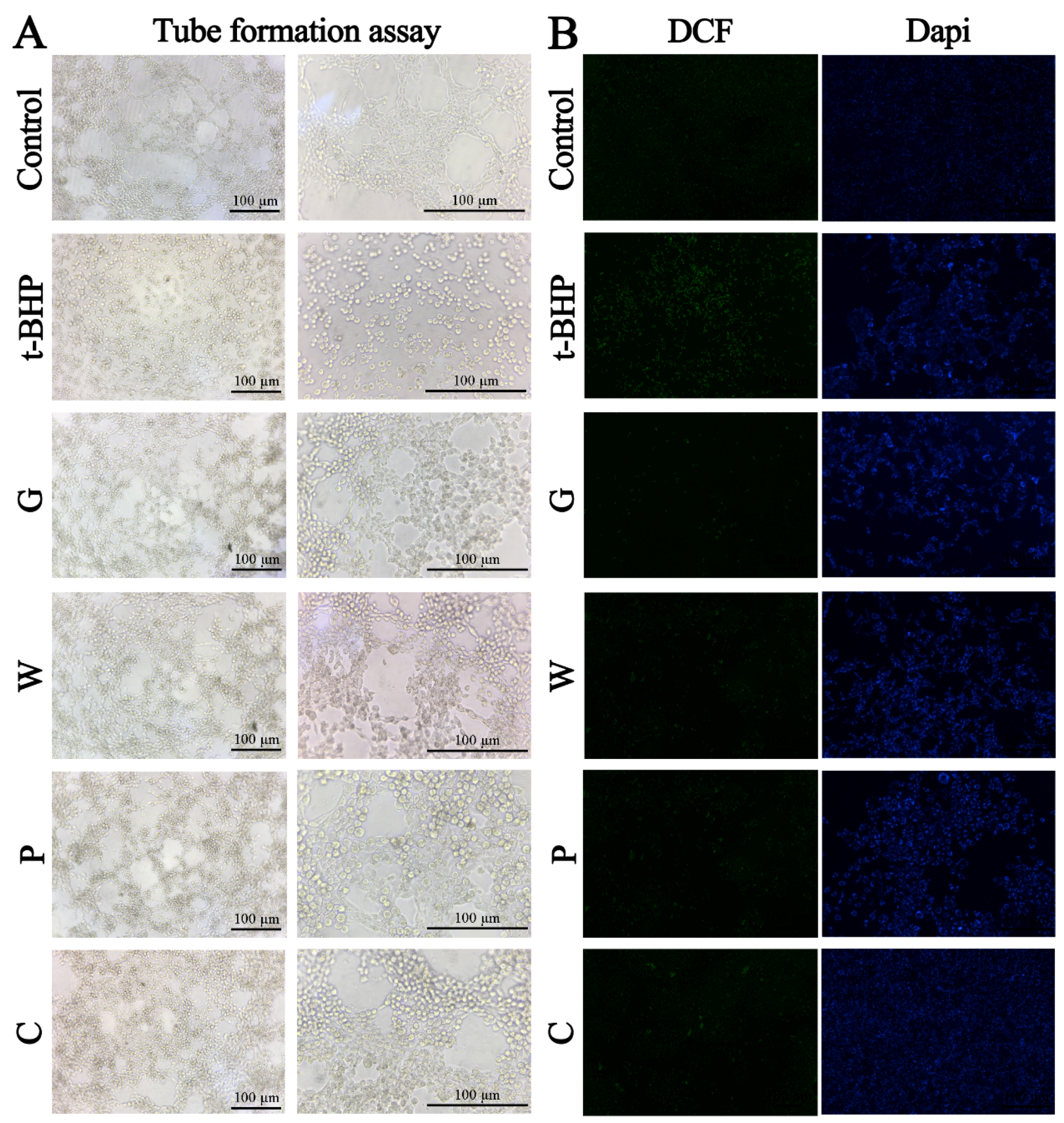
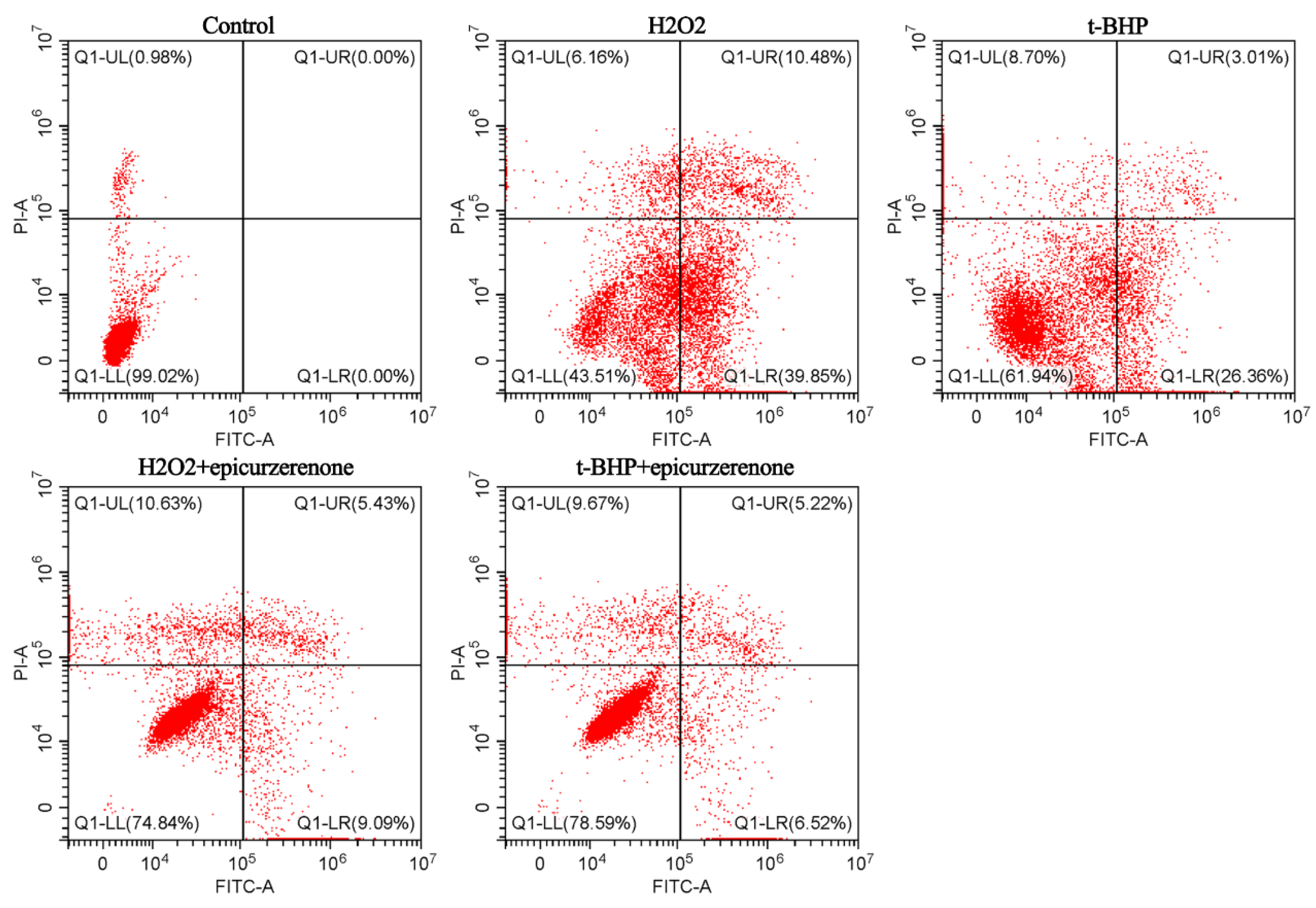
| No. | RT | Compound Name | p.value | FDR | VIP | p(corr) | Fisher’s LSD |
|---|---|---|---|---|---|---|---|
| V7 | 7.96 | 4,5-di-2-furanyl-4,5-Octanediol | 0.0000 | 0.0000 | 2.7395 | 0.3145 | P - C; P - G; P - W |
| V10 | 19.12 | 6-Methyl-2-phenyl-7-(2,4-dimethylphenylmethyl)indolizine | 0.0024 | 0.0108 | 0.3329 | 0.2820 | G - C; G - W; |
| V13 | 27.20 | beta-Myrcene | 0.0046 | 0.0170 | 1.0252 | −0.6188 | W - C; W - G; W - P |
| V14 | 27.78 | 10-epi-gamma-Eudesmol | 0.0000 | 0.0000 | 2.5892 | 0.1428 | G - C; G - P; G - W |
| V25 | 35.58 | Epicurzerenone | 0.0000 | 0.0000 | 2.9176 | 0.5755 | C - G; C - P; C - W; G - P; G - W |
| V35 | 42.36 | (E,E)-3,7-dimethyl-10-(1-methylethylidene)-3,7-Cyclodecadien-1-one | 0.0060 | 0.0204 | 1.3905 | −0.5733 | W - C; W - G; W - P |
| No. | RT | Compound Name | Match Factor | CAS# | Formula | #group Integrated Peak Area in (the Mean ± S.D.) | |||
|---|---|---|---|---|---|---|---|---|---|
| C | G | P | W | ||||||
| V25 | 35.58 | Epicurzerenone | 94.96 | 20085-85-2 | C15H18O2 | 3016994 ± 107555 | 577055 ± 150532 | 126842 ± 19496 | 44191 ± 4842 |
© 2019 by the authors. Licensee MDPI, Basel, Switzerland. This article is an open access article distributed under the terms and conditions of the Creative Commons Attribution (CC BY) license (http://creativecommons.org/licenses/by/4.0/).
Share and Cite
Cui, H.; Zhang, B.; Li, G.; Li, L.; Chen, H.; Qi, J.; Liu, W.; Chen, J.; Wang, P.; Lei, H. Identification of a Quality Marker of Vinegar-Processed Curcuma Zedoaria on Oxidative Liver Injury. Molecules 2019, 24, 2073. https://doi.org/10.3390/molecules24112073
Cui H, Zhang B, Li G, Li L, Chen H, Qi J, Liu W, Chen J, Wang P, Lei H. Identification of a Quality Marker of Vinegar-Processed Curcuma Zedoaria on Oxidative Liver Injury. Molecules. 2019; 24(11):2073. https://doi.org/10.3390/molecules24112073
Chicago/Turabian StyleCui, Herong, Beibei Zhang, Guoping Li, Lei Li, Hongshan Chen, Jinchai Qi, Wenxue Liu, Jing Chen, Penglong Wang, and Haimin Lei. 2019. "Identification of a Quality Marker of Vinegar-Processed Curcuma Zedoaria on Oxidative Liver Injury" Molecules 24, no. 11: 2073. https://doi.org/10.3390/molecules24112073
APA StyleCui, H., Zhang, B., Li, G., Li, L., Chen, H., Qi, J., Liu, W., Chen, J., Wang, P., & Lei, H. (2019). Identification of a Quality Marker of Vinegar-Processed Curcuma Zedoaria on Oxidative Liver Injury. Molecules, 24(11), 2073. https://doi.org/10.3390/molecules24112073






